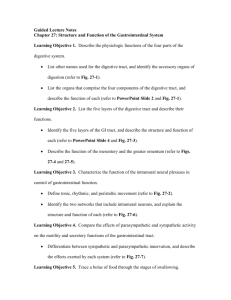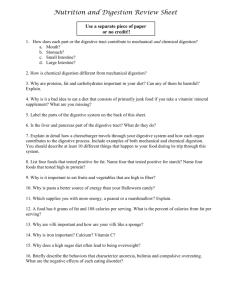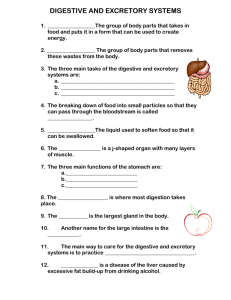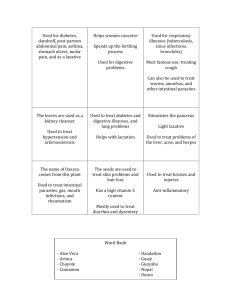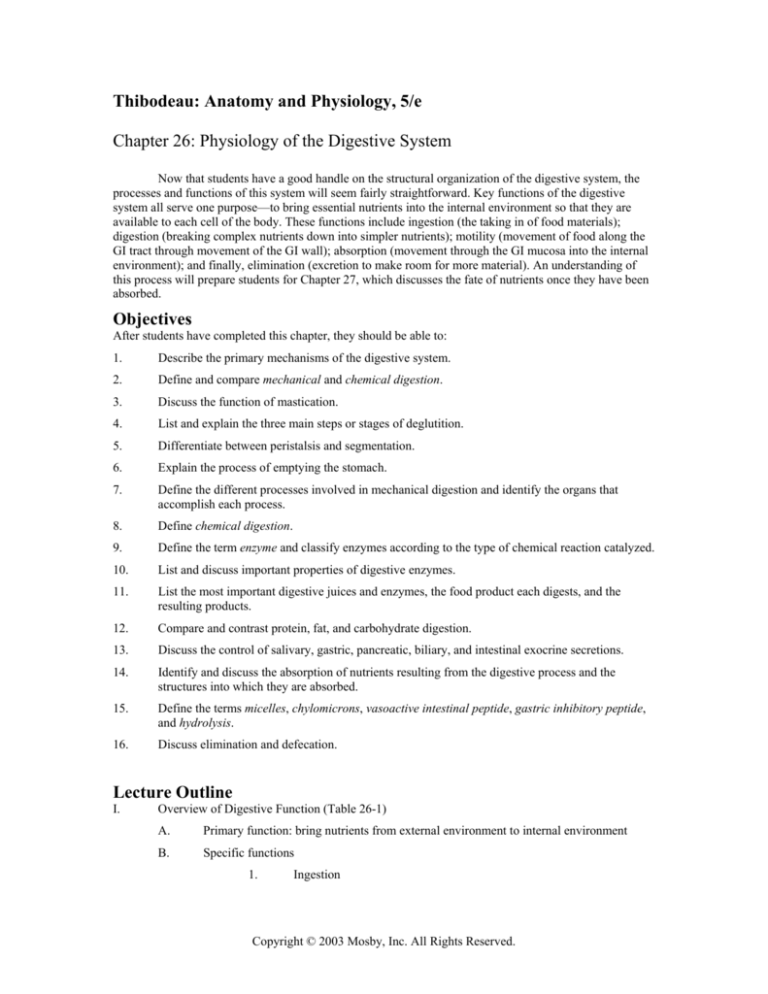
Thibodeau: Anatomy and Physiology, 5/e
Chapter 26: Physiology of the Digestive System
Now that students have a good handle on the structural organization of the digestive system, the
processes and functions of this system will seem fairly straightforward. Key functions of the digestive
system all serve one purpose—to bring essential nutrients into the internal environment so that they are
available to each cell of the body. These functions include ingestion (the taking in of food materials);
digestion (breaking complex nutrients down into simpler nutrients); motility (movement of food along the
GI tract through movement of the GI wall); absorption (movement through the GI mucosa into the internal
environment); and finally, elimination (excretion to make room for more material). An understanding of
this process will prepare students for Chapter 27, which discusses the fate of nutrients once they have been
absorbed.
Objectives
After students have completed this chapter, they should be able to:
1.
Describe the primary mechanisms of the digestive system.
2.
Define and compare mechanical and chemical digestion.
3.
Discuss the function of mastication.
4.
List and explain the three main steps or stages of deglutition.
5.
Differentiate between peristalsis and segmentation.
6.
Explain the process of emptying the stomach.
7.
Define the different processes involved in mechanical digestion and identify the organs that
accomplish each process.
8.
Define chemical digestion.
9.
Define the term enzyme and classify enzymes according to the type of chemical reaction catalyzed.
10.
List and discuss important properties of digestive enzymes.
11.
List the most important digestive juices and enzymes, the food product each digests, and the
resulting products.
12.
Compare and contrast protein, fat, and carbohydrate digestion.
13.
Discuss the control of salivary, gastric, pancreatic, biliary, and intestinal exocrine secretions.
14.
Identify and discuss the absorption of nutrients resulting from the digestive process and the
structures into which they are absorbed.
15.
Define the terms micelles, chylomicrons, vasoactive intestinal peptide, gastric inhibitory peptide,
and hydrolysis.
16.
Discuss elimination and defecation.
Lecture Outline
I.
Overview of Digestive Function (Table 26-1)
A.
Primary function: bring nutrients from external environment to internal environment
B.
Specific functions
1.
Ingestion
Copyright © 2003 Mosby, Inc. All Rights Reserved.
Chapter 26: Physiology of the Digestive System
II.
2.
Digestion
3.
Motility
4.
Secretion
5.
Absorption
6.
Elimination
2
Digestion of Two Types (p. 772)
A.
Mechanical digestion—functions to increase surface area; mix and propel food (Table
26-2)
1.
Mastication
2.
Deglutition (Fig. 26-1)
3.
4.
a.
Oral stage
b.
Pharyngeal stage
c.
Esophageal stage
Peristalsis and segmentation
a.
Peristalsis—wave of contraction that moves chyme (Fig. 26-2)
b.
Segmentation—mixing movement (Fig. 26-3)
Regulation of motility (p. 774)
a.
Gastric motility
1)
Mixing of chyme
2)
Control mechanisms
a)
Gastric inhibitory peptide (GIP)
(1)
b)
b.
Enterogastric reflex
(1)
Stimulus: acid in the duodenum
(2)
Inhibits peristalsis
Intestinal motility
1)
Peristalsis and segmentation
2)
Control mechanisms
a)
Intrinsic stretch reflexes
(1)
b)
Initiated by stretching of intestinal
wall
Cholecystokinin-pancreozymin (CCK)
(1)
B.
Stimulus for release: fat in the
duodenum
Stimulates peristalsis
Chemical digestion (Table 26-3)
1.
Digestive enzymes (p. 774)
a.
Definitions
1)
Enzyme = organic catalyst
Copyright © 2003 Mosby, Inc. All Rights Reserved.
Chapter 26: Physiology of the Digestive System
2)
2.
3.
4.
5.
Naming: substrate acted upon plus -ase suffix
c.
Classified as extracellular
d.
Classified chemically as hydrolases
Properties of digestive enzymes
a.
Specific action—"key-in-a-lock" kind of action (Fig. 26-4)
b.
Function optimally at specific pH (Fig. 26-5)
c.
Most catalyze a reaction in both directions
d.
Continually being destroyed or eliminated
e.
Most synthesized as proenzymes
Carbohydrate digestion (Fig. 26-6)
a.
Amylase (found in saliva and pancreatic juice)
b.
Sucrase, lactase, maltase (located in intestinal brush border)
Protein digestion (Fig. 26-7)
a.
Pepsin (in gastric juice)
b.
Trypsin and chymotrypsin (in pancreatic juice)
c.
Proteases (from intestinal brush border)
Fat digestion (p. 777)
b.
Emulsification essential since fats are insoluble in water (large
droplets of fat and little surface area resulting in slow
digestion)
1)
Lecithin and bile salts serving as emulsifiers
2)
Micelles (Fig. 26-8)
a)
Formed when lecithin surrounds a lipid
b)
Results in making fat water-soluble
Lipases (Fig. 26-9)
1)
Digest fats into fatty acids, monoglycerides, and
glycerol
2)
Breakdown enhanced by colipase (a coenzyme)
Residues of digestion (p. 777)
a.
III.
Digestion = hydrolysis (process of breaking large
molecules down into smaller ones)
b.
a.
6.
3
Feces
1)
Cellulose
2)
Connective tissue
3)
Undigested fats
4)
Bacteria, pigments, and water
Secretion (Table 26-4)
Copyright © 2003 Mosby, Inc. All Rights Reserved.
Chapter 26: Physiology of the Digestive System
A.
B.
Saliva
1.
Water
2.
Mucus
3.
Amylase
4.
Lipase
5.
Sodium bicarbonate
Gastric juice (p. 779)
1.
2.
C.
Chief cells (zymogenic cells)
a.
Secrete pepsinogen
b.
Pepsinogen converted to pepsin by HC1
Parietal cells (Fig. 26-10)
a.
Secrete hydrochloric acid
b.
Secrete intrinsic factor (binds to vitamin B12)
2.
Trypsin
a.
Released as trypsinogen
b.
Trypsinogen converted to trypsin by enterokinase
Chymotrypsin
a.
3.
4.
IV.
Activated by trypsin
Amylase
a.
6.
Activated by trypsin
Nucleases
a.
5.
Activated by trypsin
Lipases
a.
E.
B
Pancreatic juice (secreted by acinar cells in inactive form as zymogens)
1.
D.
4
Activated by trypsin
Sodium bicarbonate
Bile (p. 781)
1.
Lecithin and bile salts
2.
Sodium bicarbonate
3.
Bilirubin —hemolysis
Intestinal juice
1.
Mucus
2.
Sodium bicarbonate
3.
Water
Control of Digestive Gland Secretion (p. 781)
A.
Control of salivary secretion
1.
Controlled by chemical, mechanical, olfactory, and visual stimuli
Copyright © 2003 Mosby, Inc. All Rights Reserved.
Chapter 26: Physiology of the Digestive System
B.
Control of gastric secretion (Fig. 26-12)
1.
2.
3.
C.
D.
Cephalic phase
a.
Parasympathetic stimulation
b.
Gastrin secretion (Table 26-5)
Gastric phase
a.
Gastrin secretion stimulated by proteins
b.
Secretion of gastric glands stimulated by gastrin
Intestinal phase—inhibition of gastric juice secretion by gastric
inhibitory peptide (GIP)
a.
Secretin (Table 26-5)
b.
CCK (Table 26-5)
c.
Enterogastric reflex
Control of pancreatic secretion (p. 784)
1.
Secretin stimulates production of alkaline-rich pancreatic fluid
2.
Cholecystokinin-pancreozymin (CCK) effects
a.
Causes increased pancreatic secretion, high in enzymes
b.
Inhibits gastric secretion of HCl
c.
Stimulates contraction of gallbladder, releasing bile into
duodenum
Control of bile secretion
1.
Secreted continually by the liver
2.
Controlled release of bile from the gallbladder
a.
E.
Gallbladder contraction stimulated by secretin and CCK
Control of intestinal secretion
1.
Vasoactive intestinal peptide (VIP)
a.
2.
V.
5
Increases intestinal juice secretion
Neural reflexes
Absorption (Table 26-6)
A.
B.
Process of absorption (Fig. 26-13, Fig. 26-14, Fig. 26-15, Fig. 26-16)
1.
Into blood or lymph
2.
Mostly in small intestine
3.
Capillaries and lacteals in villi
Mechanisms of absorption (Fig. 26-16)
1.
Osmosis (water)
2.
Secondary active transport (sodium, glucose, amino acids) (Fig. 26-14)
3.
Diffusion (lipid micelles) (Fig. 26-15)
a.
Lipid micelles are formed from lecithin and bile salts in
intestine
Copyright © 2003 Mosby, Inc. All Rights Reserved.
Chapter 26: Physiology of the Digestive System
b.
Fatty acids and simple lipids enter the absorptive cells
c.
Inside the cell, fatty acids and monoglycerides unite to form
triglycerides
6
d.
Chylomicrons (water-soluble coats around the lipid) are
formed inside the cell
e.
VI.
Chylomicrons are into lymph lacteal diffused
Elimination (p. 787)
A.
Defecation
1.
Expelling of feces
2.
Reflex
a.
Rectum is normally empty
b.
Colonic peristalsis moves feces to rectum
c.
Distention of the rectum causes defecation desire and
relaxation of internal anal sphincter
d.
Conscious relaxation of the external anal sphincter and colonic
peristalsis results in defecation
B.
C.
VII.
VIII.
Constipation
1.
Slow movement of colon contents, resulting in too much reabsorption
of water from feces
1.
Increased motility of small intestine, resulting in less water
reabsorption
2.
Bacterial toxins
Diarrhea
The Big Picture: Digestion and the Whole Body (p. 788) (Fig. 26-17)
A.
Maintains constancy of nutrient concentration in internal environment
B.
Nervous and endocrine systems involved in control
C.
Oxygen provided by respiratory and circulatory systems
D.
Digestive organs protected by integumentary and skeletal systems
E.
Skeletal muscles: ingestion, mastication, deglutition, and defecation
Mechanisms of Disease: Disorders of the Digestive System (p. 789)
A.
Disorders of the GI tract (Fig. 26-18)
1.
Signs and symptoms
a.
Gastroenteritis
b.
Anorexia
c.
Nausea
d.
Emesis (vomiting)
e.
Diarrhea
f.
Constipation
g.
Ulcer
Copyright © 2003 Mosby, Inc. All Rights Reserved.
Chapter 26: Physiology of the Digestive System
B.
2.
Ulcer
3.
Stomach cancer
4.
Malabsorption syndrome
5.
Diverticulosis and diverticulitis
6.
Colitis
7.
Irritable bowel syndrome
8.
Colorectal cancer
Disorders of the liver and pancreas
1.
Hepatitis
2.
Cirrhosis
3.
Pancreatitis
4.
Pancreatic cancer
Copyright © 2003 Mosby, Inc. All Rights Reserved.
7


